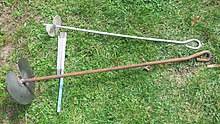Ground anchor
Ground anchors , also construction anchors or screw anchors , serve as an anchor point on the ground for taking up tensile loads, for example for tensioning masts, for rescuing vehicles, moving loads in terrain, for tensioning slack lines or rope bridges, or in agriculture (hop growing, Viticulture, securing newly planted or frail trees). In a smaller version they are used for tensioning tents and tarpaulins.
Drop anchor
Drop anchors are simple rods, on the one hand typically pointed and possibly with certain barbs, on the other end with attachment options such as eyelets, hooks or angles. They are driven directly into the ground and are suitable for hard, stony soils. Typically, they are also used for long-term constructions, they can be dismantled again without tools - and if they have barbs, only with great effort.
Ground anchor screwed
Such anchors are screwed into the ground like earth screws until only the eye can be seen. The strength that can be achieved is greater, the deeper the disc is screwed in, the wider the thread, the firmer the base, and when they sit in the direction of pull. They are not suitable for rocky or pebbled soil, or for loosely piled, unconsolidated soil. There are types with a disc (for fine, evenly cohesive soils), with a thread (for loamy and gravelly soils), and those that are inherently spiral (for looser soils).
Nailed ground anchors
Rescue organizations (technical relief organization, fire brigade, etc.) use a perforated steel rail as a "flying" anchor point, which is attached to the ground with pegs . The pegs are hammered in at an angle of 20 ° to the direction of pull in order to achieve optimum strength.
Dead man anchor
Temporary anchor: A beam is buried in the ground across the direction of pull. The pull rope is looped around the center of the beam and sunk into the ground for the first few meters.


